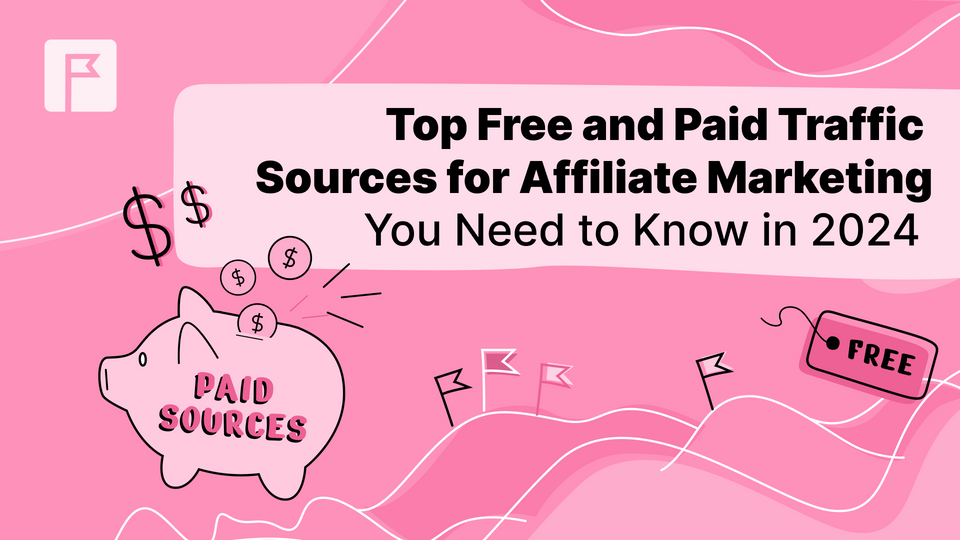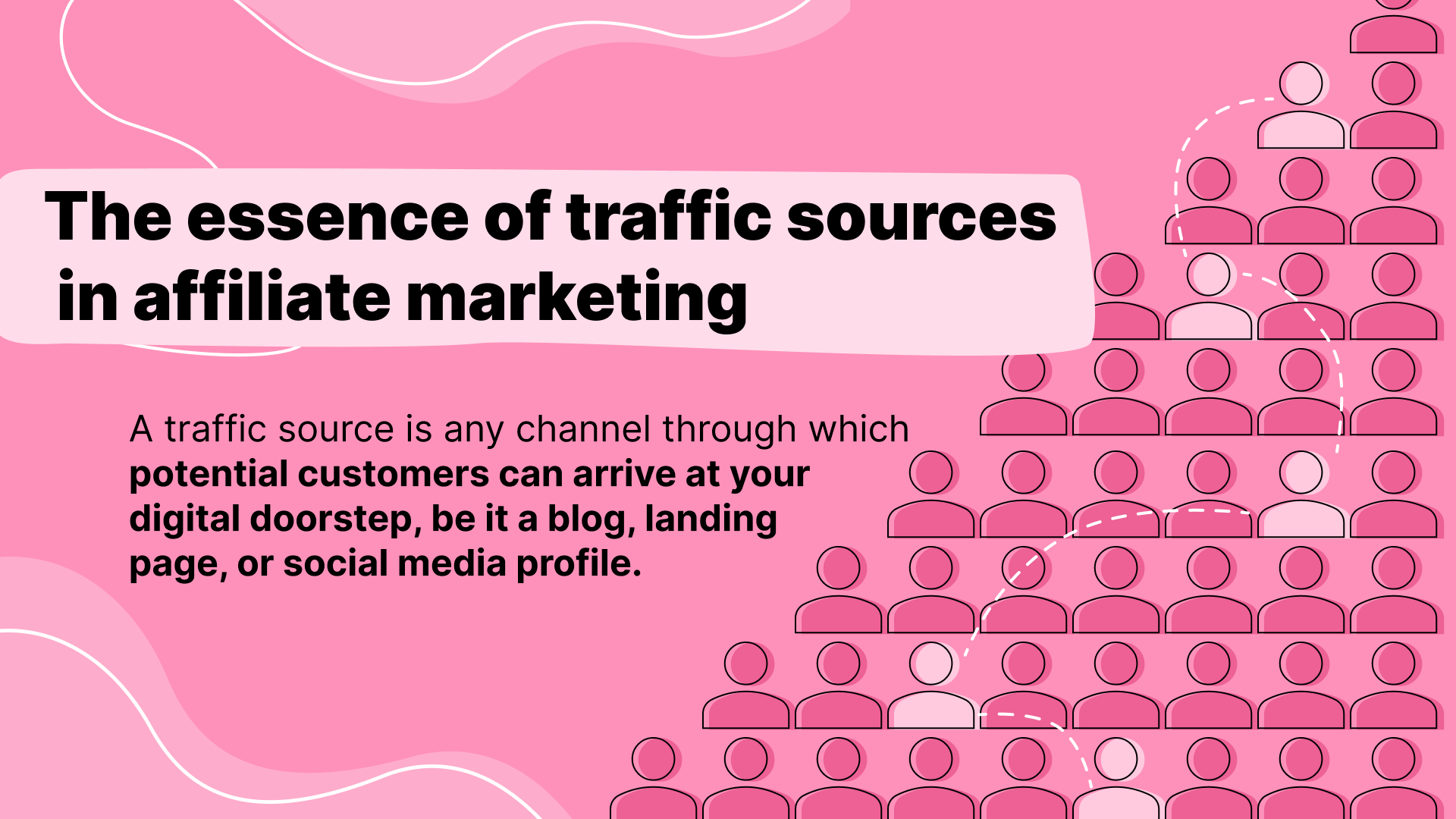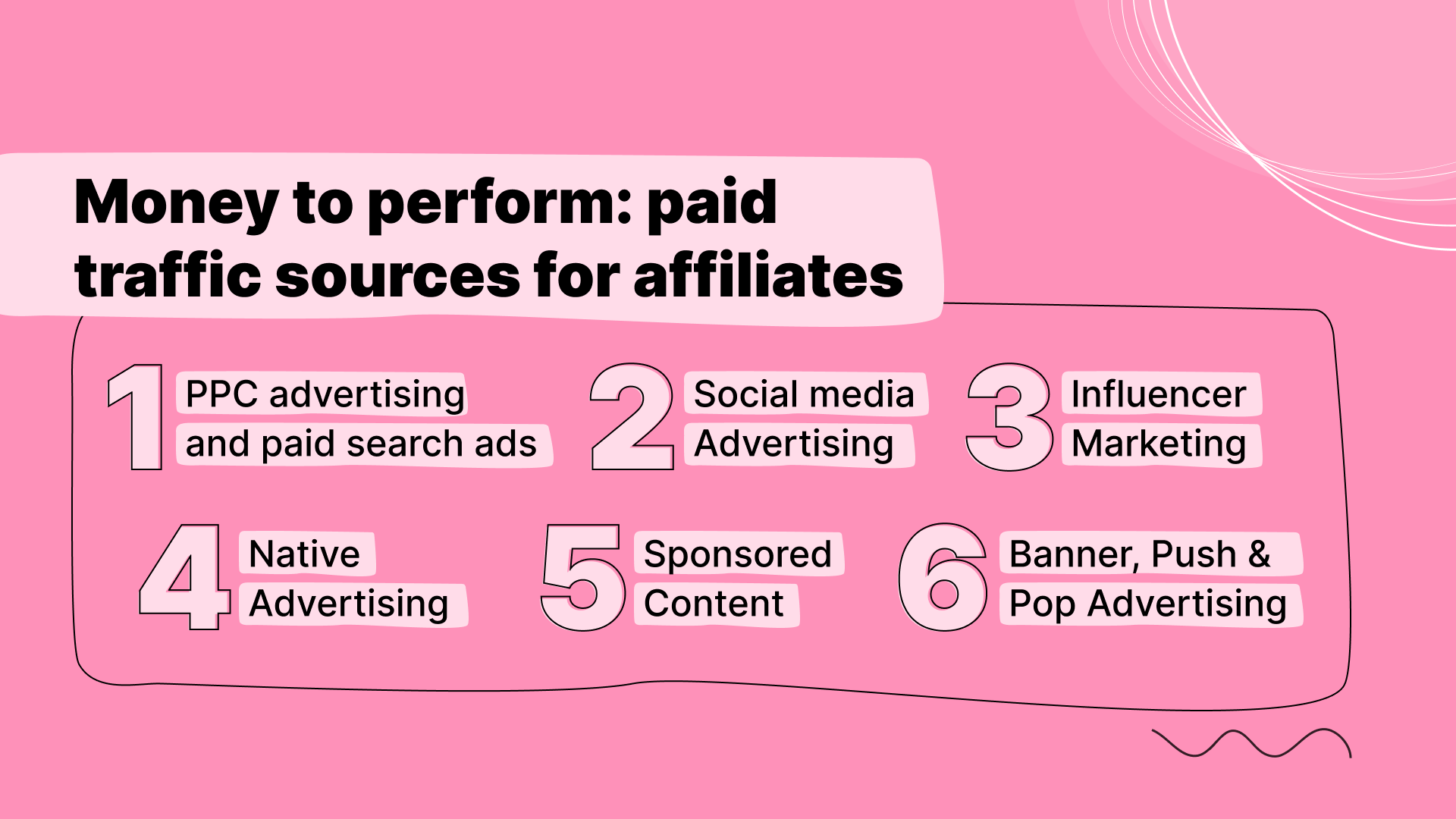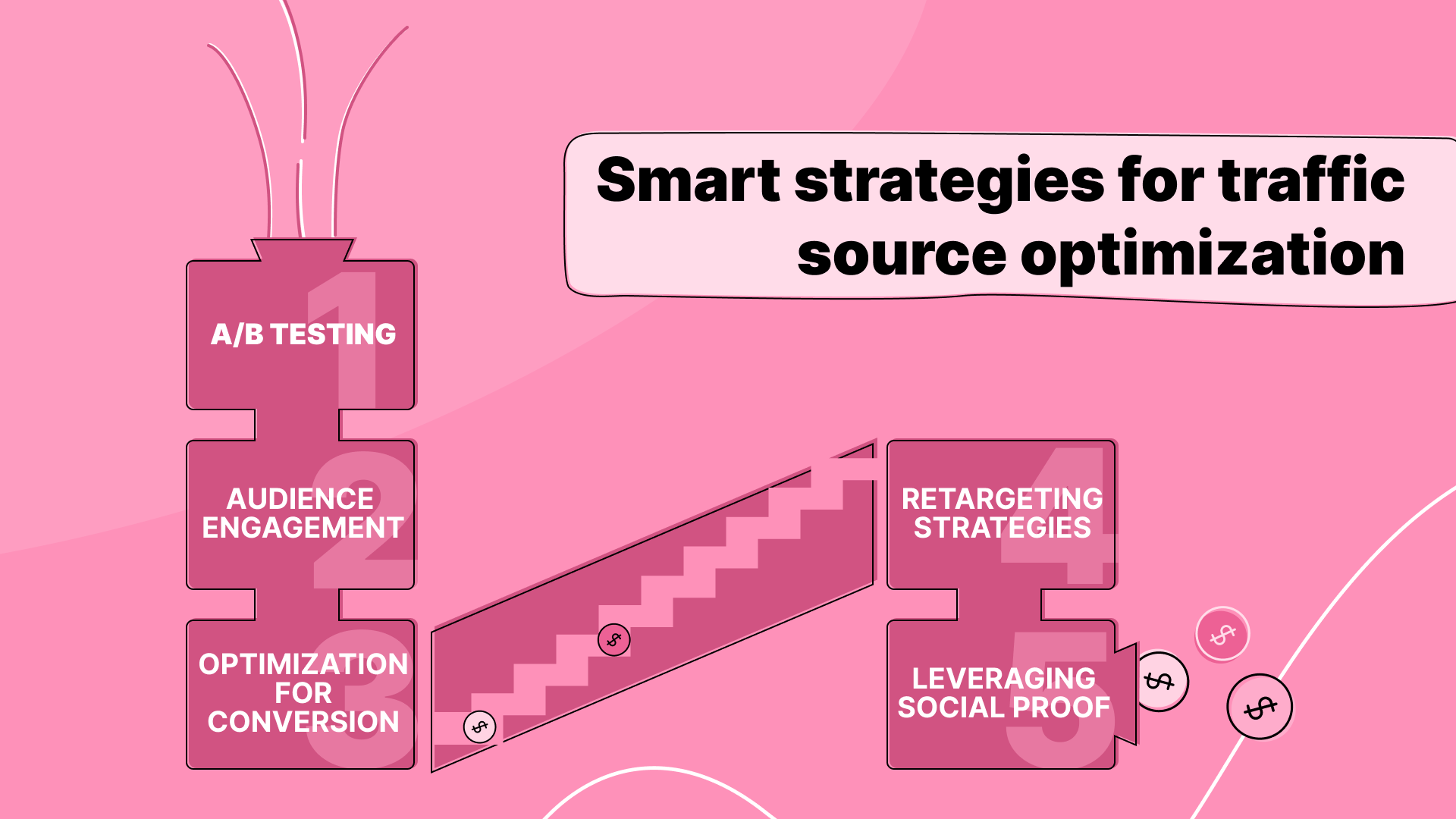Top Free and Paid Traffic Sources for Affiliate Marketing You Need to Know in 2024

As we step into 2024, affiliate marketers of any level need to adapt to the changing tides of traffic sources to stay ahead. This guide explores the most effective free and paid traffic sources for affiliate marketing, ensuring your campaigns not only reach but resonate with your target audience. Whether you're building your affiliate empire from the ground up or looking to optimize existing strategies, our in-depth overview will light the way to success.
The essence of traffic sources in affiliate marketing

The concept of traffic sources stands as a beacon of light, guiding marketers toward their ultimate goal: conversions. Understanding the nuances of these sources can transform your marketing strategy, turning passive browsing into active engagement and sales. Let's unpack the essence of traffic sources in affiliate marketing, exploring their critical role and how to effectively balance the scales between free and paid traffic.
What are traffic sources?
At its core, a traffic source is any channel through which potential customers can arrive at your digital doorstep, be it a blog, landing page, or social media profile. These sources are the vehicles that deliver your audience to the content you've carefully crafted around affiliate products or services. Whether it’s a tweet, a Google search result, or a Facebook post, each traffic source has the potential to be a vital artery pumping life into your affiliate marketing campaigns.
The importance of traffic sources in affiliate marketing cannot be overstated. They are not just routes on a map; they are intricate pathways that can lead to high engagement rates, increased brand visibility, and, most importantly, higher conversion rates. By understanding where your traffic comes from, you can tailor your content and advertisements to specific audiences, optimizing your efforts for maximum impact.
Free vs. paid traffic
The debate between free and paid traffic is as old as the internet itself, with both sides of the coin offering unique benefits and challenges.
Organic or free traffic: This type of traffic is generated organically, without direct payment for visibility. Search engine optimization (SEO), social media engagement, and content marketing are classic pillars of free traffic. The allure of free traffic lies in its cost-effectiveness and the organic relationship it builds with your audience over time. However, it's a slow burn, often requiring significant effort and patience before yielding results. The content-first approach fosters trust and authority in your niche, but it's a marathon, not a sprint.
Paid traffic: If free traffic is a marathon, paid traffic is the 100-meter dash. Through methods like pay-per-click (PPC) advertising, social media ads, and sponsored content, paid traffic sources can catapult your affiliate links in front of targeted audiences quickly. The precision targeting options allow for laser-focused campaigns, but this speed and accuracy come at a financial cost. Additionally, the reliance on paid traffic can become a crutch that, if not carefully managed, may not lead to the development of a sustainable, organic audience base.
Zero budget, maximum impact: free traffic sources for affiliates

Free traffic sources, when utilized strategically, can yield impressive results, building a sustainable foundation for affiliate marketing success. Here’s the guide on the best free traffic sources for affiliate marketing this year, offering practical tips and insights for leveraging these platforms to their full potential.
SEO (Search Engine Optimization)
SEO remains an undefeated champion in the realm of free traffic sources. By optimizing your content for search engines, you tap into the vast potential of organic search traffic, connecting with users actively seeking what you have to offer. Begin with thorough keyword research to understand what your target audience is searching for. Tools like Google Keyword Planner and Ahrefs can provide valuable insights. Focus on creating high-quality, SEO-friendly content that addresses these queries. Incorporating internal and external links strategically will further enhance your site's authority and search rankings. Remember, SEO is a long-term game — patience and consistency are key.
Social media platforms
Social media continues to be a powerful tool for affiliate marketers, with platforms like Instagram, Pinterest, Twitter (now known as X), and LinkedIn leading the charge in 2024. Each platform offers unique opportunities for organic growth:
- Instagram and Pinterest are visual-centric platforms, perfect for showcasing products and creating inspirational content. Utilize features like Instagram Reels and Pinterest Boards to increase engagement.
- The X (formerly Twitter) excels in real-time communication, allowing for the rapid sharing of links and content, perfect for time-sensitive offers.
- LinkedIn provides a professional setting, ideal for B2B affiliate marketing and establishing yourself as an industry thought leader.
Engage with your audience through comments, direct messages, and by participating in relevant conversations to build a loyal following.
Content marketing
The heart of any successful affiliate marketing strategy is compelling content. High-quality, valuable content — be it blog posts, videos, or podcasts — draws in your audience, keeping them engaged and coming back for more. Platforms like Instagram (Reels), TikTok, and YouTube offer vast audiences for video content, which can significantly increase your reach. Ensure your content is informative, and entertaining, and directly addresses the needs and interests of your target audience. By consistently providing value, you establish trust, which is crucial for converting followers into customers.
Email marketing
Building an email list is a timeless strategy for direct engagement. Unlike social media algorithms, email marketing puts you directly in your audience's inbox, allowing for personalized communication. Start by offering something of value in exchange for email signups, such as a free eBook, webinar, or exclusive content. Use segmentation and personalization to tailor your messages to specific audience interests, increasing the relevance and effectiveness of your campaigns.
Forums and online communities
Engaging in niche-specific forums and online communities can drive targeted traffic to your affiliate offers. Platforms like Reddit, Quora, and Facebook groups allow you to contribute valuable insights, answer questions, and establish yourself as a trusted authority in your niche. Always prioritize providing genuine value and adhere to community guidelines to avoid being perceived as spammy.
Money to perform: paid traffic sources for affiliates

The modern digital landscape offers a myriad of paid traffic options, each with its unique strengths and audience reach. In this part, we will highlight the most effective paid traffic sources to boost your affiliate marketing efforts, ensuring your campaigns capture and convert with precision and scale.
Pay-Per-Click advertising (PPC) and paid search ads
PPC remains a cornerstone of affiliate marketing, offering the agility to target users based on specific demographics, search queries, and interests. Platforms like Google Ads and Bing Ads serve as powerful tools to position your affiliate offers directly in front of a searching audience. Success in PPC requires a keen understanding of keyword research, ad copy optimization, and continuous performance analysis to ensure your investment yields profitable returns. Remember, the key to PPC is relevance — your ads must meet the immediate needs or interests of the searcher.
Social media advertising
Yes, you haven’t lost your mind, we've already talked about social media in a previous section as a great source of free traffic. However, the dynamic world of social media also offers fertile ground for paid campaigns. Platforms such as Facebook, Instagram, and Twitter (now known as X) provide sophisticated targeting options, allowing you to tailor your message to the exact demographic you seek. From crafting compelling ad creatives to A/B testing different messages, social media advertising demands creativity and analytical prowess. Embrace the visual and interactive nature of these platforms to create ads that not only attract, but also engage and convert.
Influencer marketing
The influence economy is booming, and for good reason. Collaborations with influencers on Instagram, YouTube, and TikTok can introduce your affiliate products to engaged and trusting audiences. Selecting the right influencer is critical — look for alignment in values, audience demographics, and engagement rates. Authentic partnerships lead to authentic endorsements, driving not just traffic but meaningful engagement that can elevate brand perception and conversion rates.
Native advertising
Native advertising blends seamlessly with the content that surrounds it, providing a less intrusive advertising experience. Platforms like Taboola and Outbrain specialize in placing your content in front of readers on reputable media sites, mimicking the look and feel of organic articles. This subtlety can lead to higher engagement rates, as the ads are perceived as recommendations rather than interruptions. Successful native advertising relies on high-quality, relevant content that resonates with the target audience.
Sponsored content
Investing in sponsored content on popular blogs, podcasts, or YouTube channels related to your niche can drive significant targeted traffic to your affiliate offers. This method offers the credibility of the content creator and the added value of their endorsement. The key to success in sponsored content lies in finding the right partners whose audiences align with your target market and whose content quality reflects well on your offers.
Banner, push, and pop advertising
While often seen as more traditional digital advertising methods, banner ads, push notifications, and pop ads can still play a vital role in your affiliate marketing strategy. This part will help you to better understand how they can be effectively utilized in your strategy.
Banner traffic
Banner advertising is one of the oldest forms of digital advertising, yet it remains a staple due to its ability to visually capture the audience's attention. These ads appear as rectangular graphics or images across the tops, sides, or bottoms of websites, acting as digital billboards. There are several types of banner ads, including:
- Static banners: Fixed images that display your message. Simple yet sometimes impactful, they're akin to traditional print ads.
- Animated banners: These use simple animations to catch the eye more effectively than their static counterparts.
- Interactive banners: Advanced banners that invite user interaction, such as hovering or clicking to reveal more information, making them more engaging and potentially increasing click-through rates.
- Video banners: Incorporating video content within the banner, these ads can tell a more compelling story or demonstrate a product more effectively.
Push traffic
Push traffic consists of notifications sent to users' devices or browsers, offering a direct line of communication. This method requires users to opt-in, thus providing a pre-filtered audience likely interested in your offers. Push notifications can be categorized into:
- Web push notifications: Sent to desktop or mobile browsers, these notifications can reach users even when they're not actively browsing your site.
- App push notifications: Exclusive to mobile apps, these can include more personalized messages based on the user’s interaction with the app.
- Rich push notifications: These include images, emojis, or buttons, making them more engaging and potentially increasing the conversion rate.
Pop traffic
Pop traffic is generated through pop-up or pop-under ads that appear over or under a user's current browser window, respectively. Although they can be seen as intrusive, when used correctly, they can effectively capture attention. Types of pop traffic include:
- Pop-up ads: These ads suddenly appear in front of the website content, prompting immediate attention. They're best used sparingly due to their potentially disruptive nature.
- Pop-under ads: Opening behind the browser window, these are less intrusive than pop-ups and can remain unnoticed until the browser window is closed, potentially leaving a lasting impression.
- Interstitial ads: Serving as a middle ground, these full-page ads appear at natural transition points, such as between pages or during loading screens, providing a less disruptive user experience.
The key to success in working with pop traffic is to choose suitable and relevant pop ad networks. Use our guide to become a PRO in this. Of course, in this extensive list of platforms, there is one that sticks out as a leader. Since 2013, HilltopAds has made its mark with a focus on Pop ads, alongside Banners, In-Page, and Video ads, appealing to a wide range of advertisers and publishers. The network distinguishes itself by delivering over 73 billion monthly ad impressions across key global regions and offering advanced targeting options for precise campaign management. It ensures high-quality, bot-free traffic and serves all major advertising verticals with various payment models like CPM, CPC, and CPA.
Smart strategies for traffic source optimization

Extracting the maximum return on investment (ROI) from each traffic source is not just a goal — it's a necessity. Whether you're leveraging free or paid traffic, understanding how to optimize these sources can significantly enhance your marketing efficiency and profitability. Let’s outline actionable strategies to help you maximize ROI from any traffic source, ensuring your marketing efforts are as fruitful as they can be.
Tracking and analytics
The backbone of any successful marketing campaign is robust tracking and analytics. Utilizing tools like Google Analytics, you can monitor the performance of different traffic sources in real time, gaining insights into user behaviour, conversion rates, and more. This data allows you to identify high-performing channels and adjust your budget or strategy accordingly. Remember, what gets measured gets managed. Regularly reviewing your analytics will enable you to make data-driven decisions, fine-tuning your approach for optimal results.
A/B testing
A/B testing, or split testing, is a methodical approach to comparing two versions of a web page, ad copy, or call-to-action (CTA) to determine which performs better. By serving two variants to similar audiences, you can scientifically measure which version yields higher conversion rates. This experimentation can reveal invaluable insights into your audience's preferences and behaviours, allowing you to refine your messaging, design, and overall strategy to boost affiliate earnings.
Audience engagement
Engaging your audience is key to converting traffic into loyal customers. Strategies for increasing audience engagement include creating interactive content like quizzes or infographics, conducting polls on social media, and sending out engaging email newsletters. These tactics not only keep your audience interested, but also provide further opportunities to understand their needs and preferences, enabling more personalized and effective marketing efforts.
Optimization for conversion
Optimizing every element of your marketing funnel, from the landing page to the checkout process, is crucial for maximizing ROI. Ensure that your landing pages are clear, concise, and optimized for conversions. This includes having a strong, visible CTA, fast loading times, and mobile responsiveness. Additionally, simplifying the checkout process can reduce cart abandonment rates and increase overall conversions.
Retargeting strategies
Retargeting allows you to reach individuals who have previously interacted with your website but did not make a purchase. By displaying targeted ads to these users as they browse other sites, you can remind them of your offers and bring them back to complete a purchase. Retargeting is a powerful tool to increase conversions and ensure your traffic sources are working effectively towards your sales goals.
Leveraging social proof
Incorporating social proof, such as customer testimonials, reviews, and case studies, can significantly enhance trust in your brand and offerings. This trust, in turn, can lead to higher conversion rates from your traffic. Highlighting positive feedback and success stories on your landing pages and in your marketing materials can sway potential customers who are on the fence about making a purchase.
Final thoughts
Why choose between free and paid traffic when you can harness the strengths of both? Integrating free and paid traffic sources into your affiliate marketing strategy offers the best of both worlds. This approach allows for immediate visibility and targeted reach through paid efforts, while simultaneously building a solid, organic foundation with free traffic.
The essence of traffic sources in affiliate marketing lies not just in their ability to direct potential customers to your content, but in their power to engage and convert these individuals into loyal customers. By understanding and effectively leveraging both free and paid traffic sources, you can create a resilient, dynamic strategy that navigates the fluctuating digital advertising business with confidence.
FAQs: Traffic sources in affiliate marketing
What is the difference between free and paid traffic sources?
Free traffic sources do not require payment to attract visitors. This includes SEO, social media engagement, and content marketing. Paid traffic sources involve paying for advertisements or promotions to drive traffic, such as PPC ads, social media ads, and influencer collaborations.
Can I rely solely on free traffic sources for my affiliate marketing?
While free traffic sources can be highly effective and cost-efficient, relying solely on them may limit your reach and growth potential. A balanced approach that includes both free and paid traffic sources is often the most effective strategy.
What are the advantages of paid traffic sources over free ones?
Paid traffic sources offer faster results and the ability to precisely target your desired audience. They are particularly useful for driving immediate traffic, testing new markets, and scaling your affiliate marketing efforts quickly.
How can I maximize ROI from paid traffic sources?
To maximize ROI, focus on targeting your ads precisely, creating compelling ad creatives, continuously testing and optimizing your campaigns, and utilizing retargeting strategies to engage users who have shown interest in your offers.
How can I choose the right traffic source for my affiliate marketing campaigns?
Consider your target audience, budget, and campaign goals. Test different traffic sources to see which ones drive the best results for your specific offers. Analysing performance data will help you identify the most effective channels for your affiliate marketing efforts.
